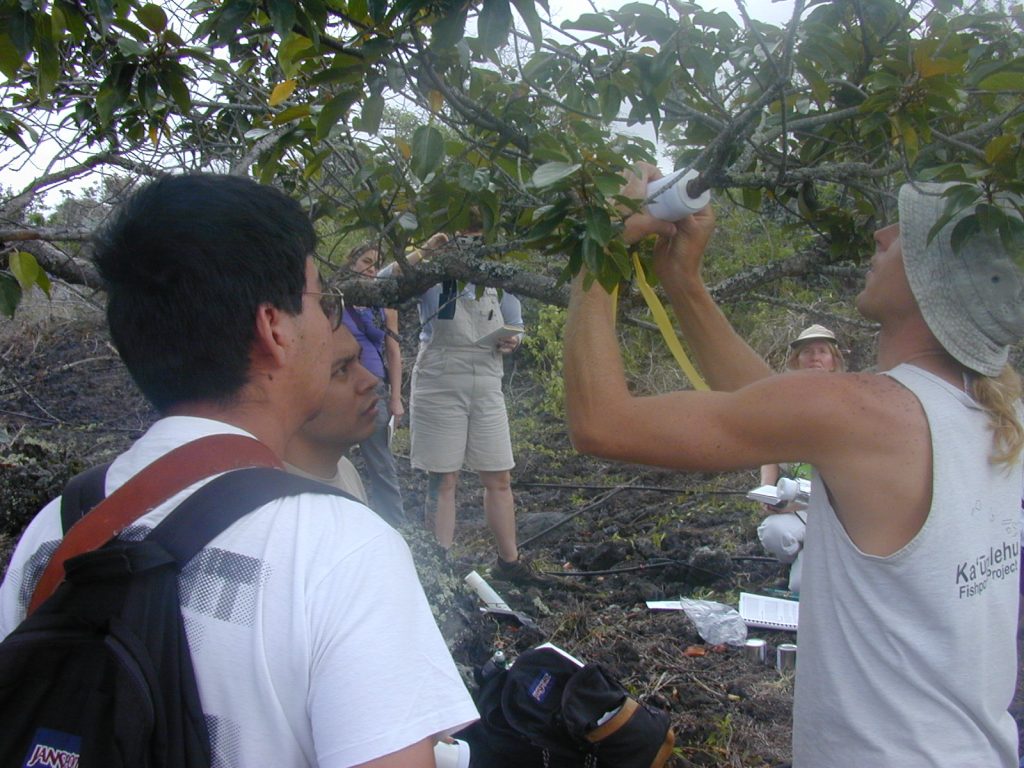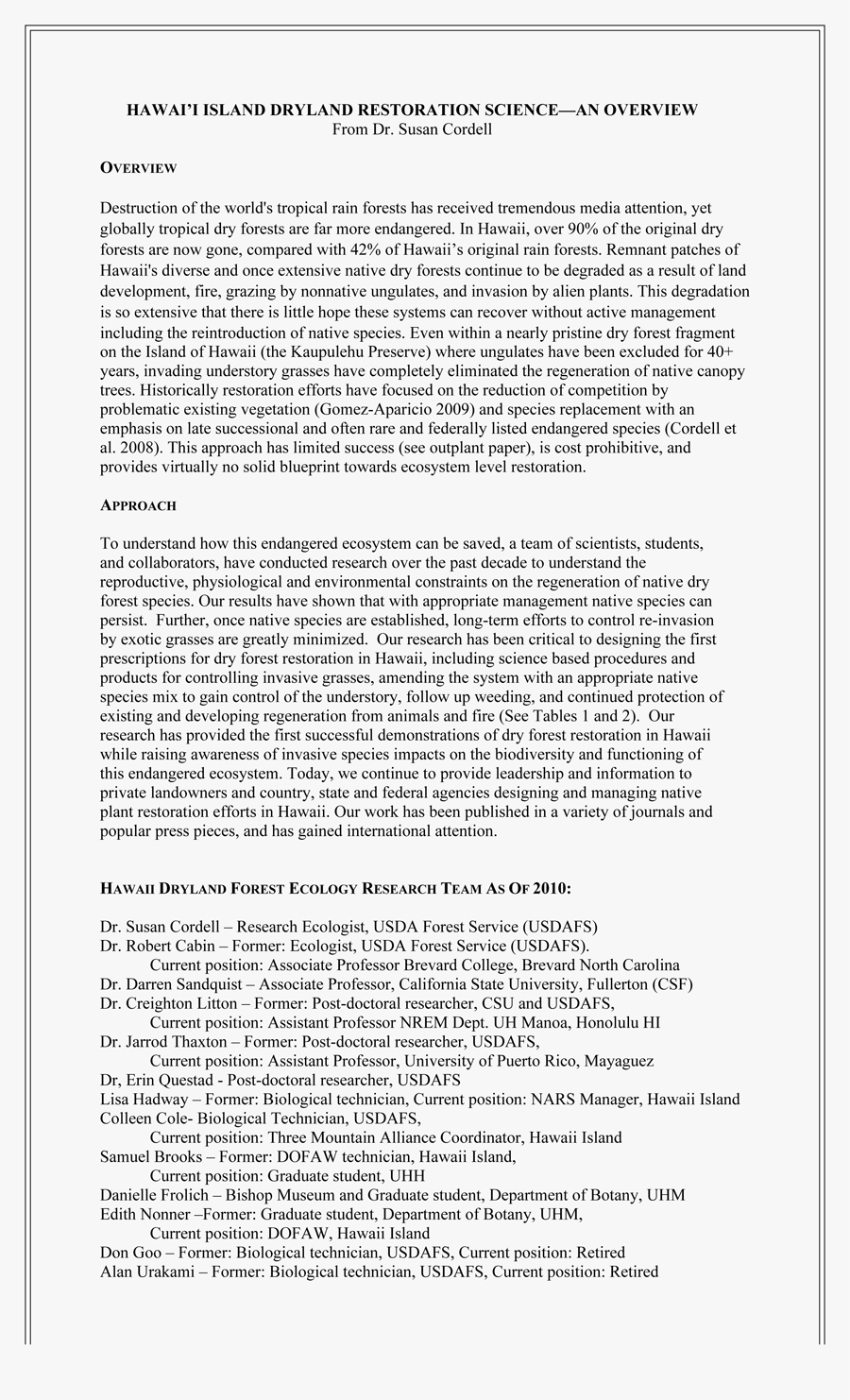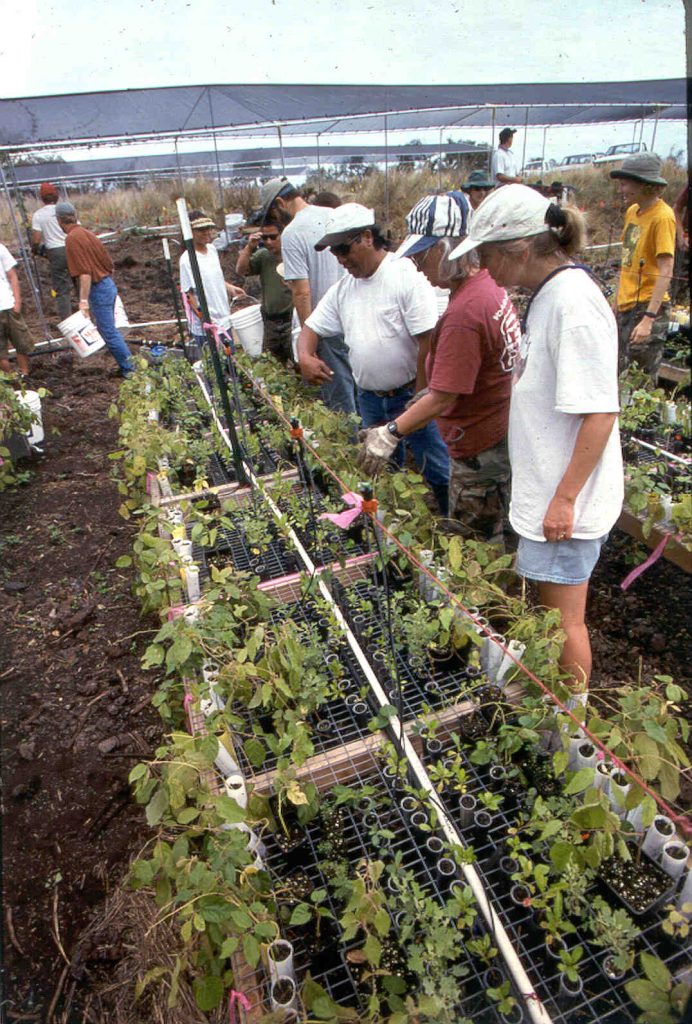Restoration Science Resources
As a result of research efforts by many organizations, including federal and state agencies, academic institutions and nonprofits, much has been learned about restoring dry forests in Hawai’i over the last 30 years. This growing body of knowledge is essential for conservation managers to understand how best to restore and care for these native habitats. Though it is impossible to include all this knowledge here, the following resources will provide a good start on this learning journey.

Setting up a sap flow guage on a Kauila tree. Photo courtesy of Susan Cordell.
Dr. Susan Cordell, Research Ecologist with the USDA Forest Service in Hilo, provides an overview of Restoration Science in the following document. The full text with an added list of reference papers by the Hawai`i Research Team is available as a pdf download below:

RESTORATION SCIENCE LINKS AND DOWNLOADS
Overview and Bibliographies
- An Overview and List of Reference Papers from Dr. Susan Cordell is the document above in its entirety, which includes research thru 2010. Several of the reference papers listed are also available for download below.
- Cordell et. al Dry Forest Publications List
- Bibliography—Dry Forest Restoration References—compiled by Susan Cordell & Cheyenne Perry.
- Pohakuloa Training Area dry forest restoration project literature list & bibliography 2002.

2001 research outplanting at Ka`ūpūlehu. Photo courtesy of Susan Cordell.
Restoration Documents
- Restoring Hawaii Dry Forests. Article describing the early efforts at Ka`ūpūlehu dryland forest restoration science: December 2000 / Vol. 50 No. 12 BioScience
- Auwahi Restoration—a story of partnering and hope at Ulapalakua, Maui. (download 4.6 MB) “Dryland forest … constitutes a small but significant part of our nation’s natural heritage. Until recently, this ecosystem was believed to be impossible to restore and destined for extinction. With multi-agency cooperation, critical information and technology has been generated that promises to shift the trajectory of this ecosystem toward recovery and long-term conservation.”
- “Aloha ‘Aina” guide to rare native plants of Hawai`i island. Includes an important section on Federal and State laws (pages 20 and 21). If you are around rare native plants this is a resource for you. (2.2 MB)
- An Assessment of Hawaiian Dry Forest Condition with Fine Resolution Remote Sensing.” A poster showing usefulness of this technology to identify tree canopy and more desirable dry forest restoration sites. The full published manuscript on this topic is available for download below.
- A general guide for restoring native plants—written in North America. Basic principles and guidelines can be adapted and facilitate thoughtful planning and factors to be considered when undertaking a new project.
- Newsletter that tells of HIPPNET dryland permanent survey plots on Hawai`i island. See their website for more: http://www.hippnet.hawaii.edu
- The Rain Follows the Forest. Hawaii’s plan for securing priority forests and watersheds to ensure fresh water drinking supply.
Restoration Science Papers, Publications, and Proceedings
- Replacement of Metrosideros polymorpha, ‘Ohi’a, in Hawaiian Dry Forest Succession by Stemmerman
- An invasive grass has significant impacts on tropical dry forest ecosystems in Hawaii: The role of science in landscape level resource management and native forest restoration in West Hawaii. 2004 SER proceedings by Cordell.
- Restoration of tropical dry forests in Hawaii: Can scientific research, habitat restoration and educational outreach happily coexist within a small private preserve? 2004 SER proceedings by Cabin.
- Fire and Alien Plants in Hawai`i: Research and Management Implications for Native Ecosystems. Smith & Tunnison.
- Genetic diversity does not affect the invasiveness of fountain grass (Pennisetum setaceum) in Arizona, California and Hawaii. 2005 Poulin et al.
- Population genetic structure of two rare tree species (Colubrina oppositifolia and Alphitonia ponderosa, Rhamnaceae) from Hawaiian dry and mesic forests using random amplified polymorphic DNA markers. 2002 Kwon & Morden.
- Repelling Invaders—Hawaiian foresters use ecology to counter invasive species. 2008 Kling.
- Revised List of Hawaiian Names of Plants Native and Introduced with Brief Descriptions and Notes as to Occurrence and Medicinal or Other Values by Joseph F. Rock Consulting Botanist, Board of Agriculture and Forestry Honolulu, Hawai‘i, 1920. Transcribed and annotated by Samuel M. ‘Ohukani‘_hi‘a Gon III
- Functional diversity of carbon-gain, water-use, and leaf-allocation traits in trees of a threatened lowland dry forest in Hawai`i. 2007 Sanquist & Cordell.
- Broadcast Seeding as a Potential Tool to Reestablish Native Species in Degraded Dry Forest Ecosystems in Hawai`i. 2009 Brooks, Cordell and Perry.
- Effects of non-native grass invasion on aboveground carbon pools and tree population structure in a tropical dry forest of Hawaii. 2006 Litton, Sandquist, & Cordell.
- A non-native invasive grass increases soil carbon flux in a Hawaiian tropical dry forest. 2008 Litton, Sandquist, & Cordell.
- An assessment of Hawaiian dry forest condition with fine resolution remote sensing. 2008 Morales, Miura, & Idol
- Emplacement of xenolith nodules in the Kaupulehu lava flow, Hualalai Volcano, Hawaii. 1995 Guestetal.
- Patterns and consequences of re-invasion into a Hawaiian dry forest restoration. Bio Invasions 2012, Erin J. Questad, Jarrod Thaxton, Susan Cordell.
- Hawaii Forests 2010. An Assessment of Hawai’i Statewide Forest Conditions and Trends and the State of our ‘Āina. Department of Land and Natural Resources (DLNR)
- Avifaunal extinctions, vegetation change, and Polynesian impacts in preshistoric Hawai‘i (Ewa Plains). Archaeology Oceania 2002, Athens, Tuggle, Ward & Welch.
- Competition between Native Hawaiian Plants and the Invasive Grass Megathyrsus maximus: Implications of Functional Diversity for Ecological Restoration.Restoration Ecology 2012, Selita Ammondt and Creighton Litton.
- Restoration of native plant communities in a Hawaiian dry lowland ecosystem dominated by invasive grass Megathyrsus maximus. Applied Vegetation Science 2012, Selita Ammondt, Creighton Litton, Lisa Ellsworth, & James Leary.
Links to Key Research and Restoration Organizations
Federal agencies
- USDA Forest Service, Institute of Pacific Islands Forestry http://www.fs.fed.us/psw/programs/ipif/ – The Institute of Pacific Islands Forestry has grown to become a center of research and technology transfer on matters of the management, preservation, and restoration, of natural ecosystems and landscapes throughout the Pacific.
- USDA Forest Service, Hawaii Experimental Tropical Forest (HETF) http://www.hetf.us/ – The Mission of the Hawaii Experimental Tropical Forest (HETF) is to provide landscapes, facilities, and data/information for those wishing to conduct research and education activities contributing to a better understanding of the biological diversity and functioning of tropical forest and stream ecosystems and their management.
- US Fish and Wildlife Service http://www.fws.gov/pacificislands/piprojects.html – Ecological Services staff use the best available science and sound managerial techniques to further the Service’s mission to conserve, protect, and enhance fish and wildlife and their habitats for the continuing benefit of the American people.
- USGS Pacific Islands Ecosystem Research Center https://www.usgs.gov/centers/pierc – PIERC ‘s mission is to work with others to provide scientific understanding and technologies needed to support and implement sound management and conservation of the Nation’s biological resources occurring in Hawai`i and other Pacific island locations.
State and University agencies
- Carnegie Airborne Observatory http://cao.stanford.edu/ – The Carnegie Airborne Observatory combines advanced spectroscopic imaging and waveform laser remote sensing technologies to study ecosystems anywhere in the world. The CAO mission is to understand how changes in land use, climate, and natural disturbances affect the structure, composition and functioning of ecosystems, and how these changes alter the services provided by ecosystems to people.
- Center for Environmental Management of Military Lands, CEMML http://www.cemml.colostate.edu/ – CEMML provides natural resource management to the U.S. Army for the Pohakuloa Training Area facility, which contains several protected dry forest remnants and endangered species.
- CTAHR – https://cms.ctahr.hawaii.edu/ – The College of Tropical Agriculture and Human Resources (CTAHR) is an integral part of the University of Hawai`i at Manoa. CTAHR is federally mandated to fulfill the University’s threefold Land Grant mission of instruction, scientific research and outreach to address State needs, such as the Rapid Ohia Death crisis.
- DLNR https://dlnr.hawaii.gov/ecosystems/napp/ – The Natural Area Partnership Program (NAPP) was established in 1991 by the state Legislature and the Governor authorizing the Department of Land & Natural Resources (DLNR) to “provide state funds for the management of private lands that are dedicated to conservation.”
- DOFAW http://dlnr.hawaii.gov/dofaw/ – The mission of DLNR’s Division of Forestry and Wildlife is to responsibly manage and protect watersheds, native ecosystems, and cultural resources and provide outdoor recreation and sustainable forest products opportunities, while facilitating partnerships, community involvement and education.
- Hawaii Permanent Plot Network http://www.hippnet.hawaii.edu/ The Hawaii Permanent Plot Network (HIPPNET) was initiated in 2007 by faculty and research ecologists at the University of Hawaii, USDA Forest Service, and UCLA to investigate forest dynamics across the island of Hawaii.
- Kamehameha Schools Bishop Estate https://www.ksbe.edu/ainaulu/ is a long time active partner of dry forest cultural ecology and restoration. They are also landowner of the important Ka`ūpūlehu dry forest and makai Kalaemanō Cultural Center. Their ‘Āina Ulu program integrates culture- and place-based education to foster kinship and kuleana between kanaka and ‘āina.
- PIPES-Pacific Internship Programs for Exploring Science http://www.uhh.hawaii.edu/uhintern/ The Pacific Internship Programs for Exploring Science (PIPES) is a university level project-based internship program housed within the Pacific Aquaculture and Coastal Resources Center at the University of Hawaii at Hilo. PIPES is committed to increasing the recruitment and retention of local students, especially those of Native Hawaiian ancestry, into fields of study, and ultimately careers, related to the natural resources of Hawai`i and the Pacific region.
- University of Hawai`i http://nativeplants.hawaii.edu/index/ is a database of Native Plants in Hawai`i, with the goal of a single, comprehensive and searchable online knowledge-base of endemic and indigenous plants of Hawaii.
Nonprofits
- Akaka Foundation for Tropical Forests https://akakaforests.org/ The Akaka Foundation’s mission is to enhance and promote a forest stewardship ethic that embraces biocultural restoration and conservation strategies through integration of traditional and western knowledge and through strategic cooperation among private and public organizations.
- Hawaii Conservation Alliance http://www.hawaiiconservation.org/ The Hawaiʻi Conservation Alliance is a partnership of organizations and agencies working together to provide unified leadership, advocacy, and collaborative action to conserve and restore native ecosystems and the unique biodiversity of our islands.
- Hawai’i Forest Institute https://www.hawaiiforestinstitute.org/ The mission of Hawai`i Forest Institute is to promote the health and productivity of Hawaii’s forests through forest restoration, educational programs, information dissemination, and support for scientific research.
- Hawai`i Association of Watershed Partnerships (HAWP) http://hawp.org/ HAWP comprises ten island-based Watershed Partnerships that work collaboratively with more than 74 public and private partners on five islands to protect over 2.2 million acres of vital forested watershed lands.
- The Kohala Center http://www.kohalacenter.org/ The Kohala Center is a community-based center for research and education. The Kohala Center was established in direct response to the request of island residents and island leaders to create greater educational and employment opportunities by caring for—and celebrating—Hawai`i Island’s natural and cultural landscape.
- National Tropical Botanical Gardens https://ntbg.org/science The National Tropical Botanical Garden (NTBG) is dedicated to discovering, saving, and studying the world’s tropical plants and to sharing what is learned. NTBG’s gardens and preserves are safe havens for at-risk species that otherwise might disappear forever. NTBG holds the lease for a 6-acre dryland forest parcel at Ka`ūpūlehu dry forest managed by the Hawai`i Forest Institute.
- The Nature Conservancy (of Hawaii) http://www.tnc-hawaii.org/ The mission of The Nature Conservancy is to preserve plants, animals, and natural communities that represent the diversity of life on Earth by protecting the lands and waters they need to survive. On Hawai’i Island they are actively restoring the Kīholo Fishponds and surrounding dry forest vegetation.
- Waikoloa Dry Forest Initiative https://waikoloadryforest.org/ The Waikoloa Dry Forest Initiative manages a forest preserve and restoration project near Waikoloa Village on Hawai‘i Island. Their mission is to preserve, protect and restore a remnant native Hawaiian dry forest ecosystem through land management, outreach, education and grass roots advocacy.
Mahalo to those who have contributed to the compilation of these lists, links and downloads, with special thanks to Dr. Susan Cordell, Cheyenne Perry and Dr. Creighton Litton.
